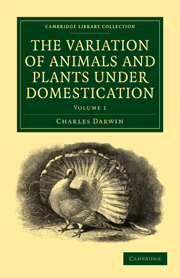Book contents
- Frontmatter
- Contents
- LIST OF ILLUSTRATIONS
- INTRODUCTION
- CHAPTER I DOMESTIC DOGS AND CATS
- CHAPTER II HORSES AND ASSES
- CHAPTER III PIGS — CATTLE — SHEEP — GOATS
- CHAPTER IV DOMESTIC RABBITS
- CHAPTER V DOMESTIC PIGEONS
- CHAPTER VI PIGEONS—continued
- CHAPTER VII FOWLS
- CHAPTER VIII DUCKS — GOOSE — PEACOCK — TURKEY — GUINEA-FOWL — CANARY-BIRD — GOLD-FISH — HIVE-BEES—SILK-MOTHS
- CHAPTER IX CULTIVATED PLANTS: CEREAL AND CULINARY PLANTS
- CHAPTER X PLANTS continued — FRUITS — ORNAMENTAL TREES — FLOWERS
- CHAPTER XI ON BUD-VARIATION, AND ON CERTAIN ANOMALOUS MODES OF REPRODUCTION AND VARIATION
CHAPTER IV - DOMESTIC RABBITS
Published online by Cambridge University Press: 05 October 2010
- Frontmatter
- Contents
- LIST OF ILLUSTRATIONS
- INTRODUCTION
- CHAPTER I DOMESTIC DOGS AND CATS
- CHAPTER II HORSES AND ASSES
- CHAPTER III PIGS — CATTLE — SHEEP — GOATS
- CHAPTER IV DOMESTIC RABBITS
- CHAPTER V DOMESTIC PIGEONS
- CHAPTER VI PIGEONS—continued
- CHAPTER VII FOWLS
- CHAPTER VIII DUCKS — GOOSE — PEACOCK — TURKEY — GUINEA-FOWL — CANARY-BIRD — GOLD-FISH — HIVE-BEES—SILK-MOTHS
- CHAPTER IX CULTIVATED PLANTS: CEREAL AND CULINARY PLANTS
- CHAPTER X PLANTS continued — FRUITS — ORNAMENTAL TREES — FLOWERS
- CHAPTER XI ON BUD-VARIATION, AND ON CERTAIN ANOMALOUS MODES OF REPRODUCTION AND VARIATION
Summary
All naturalists, with, as far as I know, a single exception, believe that the several domestic breeds of the rabbit are descended from the common wild species; I shall therefore describe them more carefully than in the previous cases. Professor Gervais states “that the true wild rabbit is smaller than the domestic; its proportions are not absolutely the same; its tail is smaller; its ears are shorter and more thickly clothed with hair; and these characters, without speaking of colour, are so many indications opposed to the opinion which unites these animals under the same specific denomination.” Few naturalists will agree with this author that such slight differences are sufficient to separate as distinct species the wild and domestic rabbit. How extraordinary it would be, if close confinement, perfect tameness, unnatural food, and careful breeding, all prolonged during many generations, had not produced at least some effect! The tame rabbit has been domesticated from an ancient period. Confucius ranges rabbits among animals worthy to be sacriflced to the gods, and, as he prescribes their multiplication, they were probably at this early period domesticated in China. They are mentioned by several of the classical writers.
- Type
- Chapter
- Information
- The Variation of Animals and Plants under Domestication , pp. 103 - 130Publisher: Cambridge University PressPrint publication year: 2010First published in: 1868



